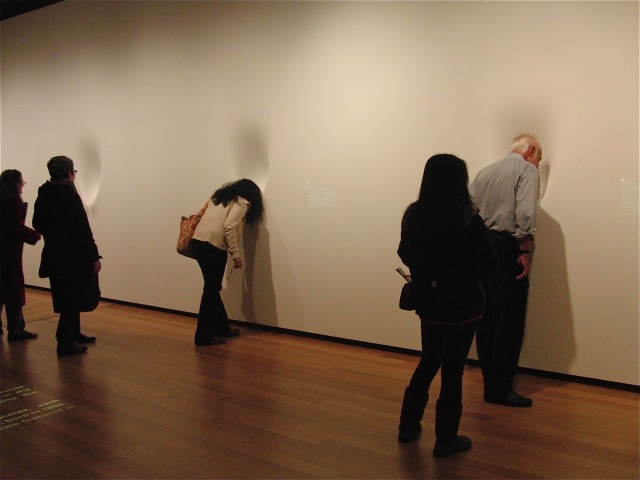
Fragrant exhibition at Museum of Arts and Design take visitors on an olfactory tour of the history of perfume (photo by twi-ny/mdr)
Museum of Arts and Design
2 Columbus Circle at 58th St. & Broadway
Through March 3
800-838-3006
www.madmuseum.org
A rather unique exhibit at the Museum of Arts & Design in Columbus Circle, one that truly “stinks,” has been extended through March 3. “The Art of Scent 1889-2012” collects twelve of the world’s most beloved, influential, and (in)famous perfumes, displaying them as if they were sculptures or paintings, firmly establishing them as individual works of art. Designed by the architectural firm Diller Scofidio + Renfro, the exhibition, the first major museum retrospective to elevate perfume in such a way, consists of a dozen stations along a wall, indentations where visitors put their head in and breathe in the fragrances, accompanied by an illuminated paragraph that appears then disappears, like the smells themselves, detailing the scent’s creator and development. Curated by Chandler Burr, the fragrances are arranged chronologically, following the changing trends in the industry, including the implementation of synthetic materials and modern technology. First up on the aromatic tour is Aimé Guerlain’s 1889 scent Jicky, which combines the terpene alcohol linalool, the chemical compound coumarin, and the flavorant ethyl vanillin; the text explains, “Though subtle in effect, the synthetics were both disorienting and liberating. By freeing olfactory artists from an exclusively natural palette, they turned scent into an artistic medium, and made Jicky one of the first true works of olfactory art.” Museumgoers will react differently to each scent as they get whiffs of Enest Beaux’s Chanel N°5, Pierre Wargnye’s Drakkar Noir, Annie Buzantian and Albert Morillas’s pleasures, Jean-Claude Ellena’s Osmanthe Yunnan, and Daniela Andrier’s disturbing Untitled, lent by such parfumeries as Hermès, Prada, L’Oréal, Clarins, Estée Lauder, Clinique, Guerlain, and other cosmetic companies. A second room delves into further detail about the creation of perfume with video interviews, a multipart evolution of one particular scent, and a table where visitors can dip strips into the actual liquid products and sample the real thing. The deluxe catalog ($285) includes eleven of the perfumes in printed glass vials — only Chanel chose not to participate — with each scent assigned to a different artistic discipline: Francis Fabron’s L’Interdit is considered abstract expressionism, Olivier Cresp’s Angel surrealism, Jacques Cavallier’s L’Eau d’issey minimalism, and Untitled post-brutalism. On February 13, MAD will host the special program “Technology and Innovation in Fine Fragrance,” with Burr and Rochas house perfumer Jean-Michel Duriez leading an interactive discussion in which attendees will be able to sniff-sample raw materials and complex fragrances.